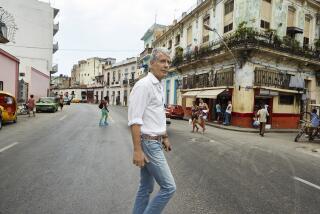Caught in the Trap of Central American Intrigue : DEADFALL <i> by Patti Davis (Crown: $17.95; 262 pp.; 0-517-57405-5)</i>
At the turning point of “Deadfall,” Patti Davis’ novel about political conspiracy and personal tragedy, Andrew Laverty succumbs to an aimless rage that leads him to his death.
Laverty, a documentary film maker disinherited for his anti-war views, becomes the victim of a CIA-backed plot he is trying to expose. It is 1989 in Nicaragua, and the conspirators are working to escalate the fading Contra war into direct U.S. involvement. When they steal some telltale footage he has shot there, he goes back and films more, only to find American producers uninterested in what one calls “last year’s cause.”
Driven by an energy that is “raw and almost frantic,” the film maker turns to a different crusade. For reasons the author doesn’t dwell on, nightmares about Nicaragua’s dead make Laverty think of right-wing death squads in El Salvador. His own death comes in the bombing of a Los Angeles church where he has gone to help shelter illegal Salvadoran refugees.
That passage tells a lot about the strengths and limitations of Davis’ second novel. “Deadfall” is a haunting psychodrama of how three people drawn into Laverty’s investigation--his pregnant widow, a U.S. senator and a journalist--take up his struggle to stop American intervention in Nicaragua and how they suffer for it. But like Laverty, the author seems to have seized upon a purpose at random, with raw and frantic energy, without knowing what she was getting into.
The publisher tells us that the story “takes place in Nicaragua.” But it is really no more about Nicaragua than it is about El Salvador or the subject of her previous novel, Vietnam. “Deadfall” takes place largely in Davis’ imagination and treats Nicaragua as a caricature, a prop for her assault on the politics of Cold Warriors like her father, former President Ronald Reagan, who have held up that country as a symbol of Communist expansion without understanding it very well either.
A novel like this hardly contributes to the real debate over Nicaragua today--how to help an utterly polarized society along its slow, painful path toward reconciliation. The only hint Davis offers about the country’s complexities is that the Contras sometimes pose as Sandinistas to sow confusion among their victims. In her view, the Contra insurgency is an obscene American imposition, “a revolution that was our idea in the first place.”
There’s little room for anything more insightful; only six of the book’s 34 chapters are set in Nicaragua and reflect some confusion about the geography. Obviously, the author is more at home in the fog of Santa Monica Canyon, where most of the action occurs.
If there’s a valid political message in “Deadfall,” it is simply that the Nicaraguan war, though winding down, is not yet over. As long as Washington won’t disband the Contras and come to terms with the Sandinista revolution, the prospect for a violent flare-up is greater. But with Congress exhausted by years of debate over Nicaragua and skeptical of the Administration’s every move there, how could American troops possibly get involved at this point?
To drive her warning home, Davis needs a credible scenario for U.S. intervention. But she doesn’t produce one. The pretext for a dispatch of American troops, the assassination of a U.S. senator in Managua, is treated too sketchily in the book. For some reason, the author has Sean Trudell, the only American reporter at the shooting scene, walk away from the story--an action inconceivable to a real journalist!
Davis also expects her readers to believe that CIA operatives can sit around Managua’s hotels and restaurants, as they might do in Honduras, boasting of bloody misdeeds and plotting new ones without getting caught. In one unlikely passage, a North American killer leaves his calling card at a massacre scene on the outskirts of Esteli, a major town. This is too much. Davis underrates the Sandinista State Security police, who are more ruthless and efficient than she would probably like to believe. And she forgets how hard it was for farmer Eugene Hasenfus to blend in with Nicaraguans after his CIA flight was shot down in 1986.
Although the conspiracy is unconvincing, Davis has created some realistic characters to suffer its consequences and some vivid imagery to convey their feelings of helplessness. A “deadfall” is a kind of game hunter’s trap, she explains at the outset, and then goes on to describe, as the story unfolds, what it feels like in figurative human terms to be caught in one. All this makes “Deadfall,” despite its shortcomings, a good, suspenseful read.
Darren Laverty, the film maker’s widow, is the center of the novel as she struggles to prove that her husband was murdered, nurtures his unborn child, suffers betrayal by her own family and comes to realize how much she fears knowing the killer’s identity.
Sen. Kent Janes is driven to Darren’s cause by his own family tragedy, only to find that his mentally ill wife has walked into the conspirators’ trap. Davis’ narrative invades their dreams, intimate relationships and musings on death in its many forms--the sudden bomb blast, the seduction of sleeping pills, the slow shriveling of the soul.
But without a credible scenario or insightful message to support it, all this suffering seems like such a gratuitous waste. As “Deadfall” nears a climax, the characters become so introspective in their anguish that the reader almost forgets Nicaragua and its misfortunes. After one novel with a co-author, Davis has proven with this one that she can write. Now she should look for a purpose closer to home.
More to Read
Sign up for our Book Club newsletter
Get the latest news, events and more from the Los Angeles Times Book Club, and help us get L.A. reading and talking.
You may occasionally receive promotional content from the Los Angeles Times.






